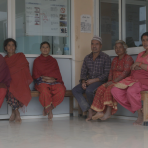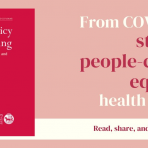By Saqif Mustafa (World Health Organization), Yu Zhang (World Health Organization), Zandile Zibwowa (World Health Organization), Redda Seifeldin (World Health Organization), Louis Ako-Egbe (World Health Organization Country Office, Monrovia, Liberia), Geraldine McDarby (World Health Organization), Edward Kelley (World Health Organization), Sohel Saikat (World Health Organization)
COVID-19 has been with us for over a year and a half now and despite some evidence of service restoration, profound disruptions to essential health services persist globally. Health systems resilience – the ability to effectively respond to shocks while maintaining routine and core functions, and adapting to evolving threats – is critical to maintaining progress and ensuring sustained universal health coverage and health security. Building resilient health systems requires an integrated approach to health sector planning and utilising lessons learned from past and ongoing events.
During and after the 2014-16 Ebola Virus Disease outbreaks in West Africa, health systems resilience became ubiquitous. There was widespread acknowledgement that the indirect effects of Ebola on health and health systems were greater than the devastating direct impact of Ebola on morbidity and mortality (e.g. an additional 11,000 malaria, HIV/AIDS and tuberculosis deaths alone). The indirect impact of COVID-19 on excess morbidity and mortality is still being counted and emerging evidence suggests the total exact toll could be huge.
Despite numerous calls to build health systems resilience to major crises such as infectious disease outbreaks and pandemics, an integrated approach to strengthening health systems globally and nationally has been limited. By an integrated approach, we mean the coming together, participation and joint working of those actors responsible for health security, humanitarian, and disease- and life-course-specific programmes as well as those working on strengthening the building blocks of the health system (e.g. governance, health financing, health workforce, essential health products, health information systems and service delivery). Past emergencies have revealed a cycle of ‘panic and neglect’ and limited ability to deploy a whole-of-government and whole-of-society approach with health in all policies. COVID-19 has again exposed these gaps and prevailing fragmentations in efforts to strengthen health systems. It is within this context that we reviewed COVID-19 preparedness and response plans from 106 countries in our recent Health Policy and Planning article.
There are a few critical considerations that should be highlighted from this study that can inform ongoing and future policy and operational planning:
- There is scope to better embed considerations for maintaining routine health systems functionality in emergency planning
We found that 47% of COVID-19 preparedness and response plans (CPRPs) considered the maintenance of non-COVID-19 essential health services. During an emergency, the predominant focus of decision makers is invariably on the crisis itself. Therefore, prior to the occurrence of an emergency, health sector and health emergency planning should establish the structures and platforms needed for joint working and active involvement of those responsible for health security, humanitarian, disease- and life-course-specific programmes, health systems strengthening, and universal health coverage; and crucially maintain inter- and multi-sectoral working in all contexts.
- Better integration can provide added value
By integrating efforts across health security, humanitarian and disease- and life-course-specific programmes and investing in health systems so they are able to tackle multiple and diverse threats, this can save costs, provide greater efficiency, enable accountability and build trust. This is especially important given the impact of COVID-19 on the economy globally and dwindling development assistance and external funding for health.
- Guidance from the WHO and UN is well adopted in country level policy and planning
The WHO and broader UN system developed and continues to develop and update guidance as the evidence base evolves at an unprecedented rate. Overall, our findings indicate good alignment of national plans with the global planning guidance. This consistency observed during the course of COVID-19 response can be harnessed and extended during the health systems recovery process as well as in routine health systems planning for achieving universal health coverage and health security as interdependent objectives.
- Countries across all income groups had disruption in maintaining essential health services
There is no clear trend between specific country income groups and planning considerations for the maintenance of essential health services. This aligns with the widespread service disruptions observed including in high-income countries that were ranked top for health systems performance in terms of universal health coverage and health security scores. The political and governance context, ability to rapidly deploy whole-of-government and whole-of-society resources, extent of investment (or disinvestment) in essential public health functions, and establishing linkages between public health activities and clinical care are likely factors that contribute to better health systems resilience.
- COVID-19 is a once-in-a-generation opportunity for integrated health system strengthening
Our study provides evidence on the current state of integration in planning between emergency preparedness and response activities and broader, routine health systems functions which can inform the building of more integrated, resilient health systems for ongoing and future threats. As COVID-19 vaccines are deployed, health systems are now transitioning from a predominant focus on acute response to a combination of tackling smaller outbreaks, variants of concern and recovery of routine and essential health services. The pandemic has brought about unprecedented global media, political and investment attention on health systems strengthening for both health security and universal health coverage objectives. Health sector decision makers should continually appraise their health systems performance from policy and planning to operational levels, and leverage the attention and investments brought about by COVID-19 to build back better, more integrated and resilient health systems.
Photo credit: WHO / Andre Rugema
















